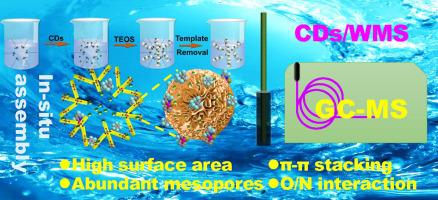提出了一种原位合成策略,用于制造嵌入碳点的皱纹介孔二氧化硅 (CDs/WMS) 微球。表征结果表明,掺杂中等含量的 CDs 仍然可以使微球保持起皱和高度介孔的结构。随后将 CDs/WMS 复合材料用作固相微萃取 (SPME) 涂层,用于灵敏测定水溶液中的超痕量有机氯农药 (OCP)。与商业 SPME 涂层和纯 WMS 相比,高表面积、丰富的化学基团和丰富的孔隙率使得 CDs/WMS 微球对 OCPs 具有优异的提取能力。在最佳提取条件下,所提出的分析方法表现出宽线性范围 (0.2–1000 ng/L)、低检测限 (0.0023–0. 水为 073 ng/L,果汁为 0.0062–0.41 ng/L),重现性令人满意,水和果汁的相对标准偏差分别为 6.2%−13.3% 和 7.3%−13.2%。最后,该方法成功用于实际水和果汁样品中 OCPs 的测定。水的回收率从 80.1% 到 105.2% 不等,果汁的回收率从 71% 到 106.8% 不等。本研究开发了一种合成 CDs/WMS 微球的新策略,并提出了一种新型 SPME 涂层,扩大了 CDs 从水溶液中捕获有机污染物的潜力。该方法成功用于实际水和果汁样品中OCPs的测定。水的回收率从 80.1% 到 105.2% 不等,果汁的回收率从 71% 到 106.8% 不等。本研究开发了一种合成 CDs/WMS 微球的新策略,并提出了一种新型 SPME 涂层,扩大了 CDs 从水溶液中捕获有机污染物的潜力。该方法成功用于实际水和果汁样品中OCPs的测定。水的回收率从 80.1% 到 105.2% 不等,果汁的回收率从 71% 到 106.8% 不等。本研究开发了一种合成 CDs/WMS 微球的新策略,并提出了一种新型 SPME 涂层,扩大了 CDs 从水溶液中捕获有机污染物的潜力。
 "点击查看英文标题和摘要"
"点击查看英文标题和摘要"
In-situ synthesis of carbon dots embedded wrinkled-mesoporous silica microspheres for efficiently capturing and monitoring organochlorine pesticides from water and fruit juice
An in-situ synthesis strategy was proposed for fabrication of carbon dots embedded wrinkled mesoporous silica (CDs/WMS) microspheres. Characterizations results demonstrated that the doping of CDs with a moderate content still allowed the microspheres to maintain wrinkled and highly mesoporous structures. The CDs/WMS composite was subsequently employed as solid phase microextraction (SPME) coating for sensitive determination of ultra-trace organochlorine pesticides (OCPs) from aqueous solutions. High surface area, abundant chemical groups, and plentiful porosity made CDs/WMS microspheres present superior extraction capacities for OCPs compared with commercial SPME coatings and pure WMS. Under the optimum extraction conditions, the proposed analytical method exhibited wide linearity range (0.2–1000 ng/L), low detection of limits (0.0023–0.073 ng/L for water, 0.0062–0.41 ng/L for fruit juice), and satisfactory reproducibility with relative standard deviations of 6.2 %−13.3 % and 7.3 %−13.2 % for water and fruit juice, respectively. Finally, the proposed method was successfully used for determination of OCPs in real water and fruit juice samples. The recoveries varied from 80.1 % to 105.2 % for water and 71 % to 106.8 % for fruit juice. This study developed a novel strategy for synthesis of CDs/WMS microspheres, and proposed a new type of SPME coating, which expanded the potential of CDs in capturing organic pollutants from aqueous solutions.




















































 京公网安备 11010802027423号
京公网安备 11010802027423号